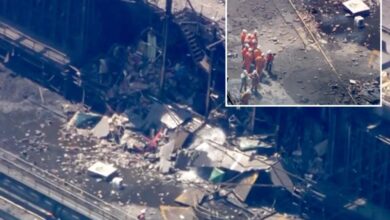Nuclear winter would bring mass starvation, death for years post-war, startling new study reveals: ‘We must be prepared’

It would be a-crop-alyptic.
Amid rising tensions around the world, Penn State University scientists have revealed what the fallout would be from a nuclear war — with an unfathomable famine, mass deaths and a particular impact on an important crop after the bombs went off.
According to the dystopian study, published in the journal Environmental Research Letters, the destruction would “extend well beyond the blast zones” because of nuclear winter, a catastrophic theoretical scenario in the wake of a nuke conflict.
“Nuclear wars would cause an unfathomable loss of life and genetic resources, but also a prolonged nuclear winter that would reduce agricultural area and productivity for years,” the team wrote.
During this apocalyptic aftermath, smoke and soot from the firestorms would blot out the sun, causing global cooling that would devastate agriculture worldwide, per a release from Penn State. This could last for more than a decade, leading to widespread famine among the survivors of the initial conflict.
To determine the exact extent of this devastation, the research team simulated the effects of nuclear winter on the global production of corn — the most widely grown grain crop in the world.
“We simulated corn production in 38,572 locations under the six nuclear war scenarios of increasing severity – with soot injections ranging from 5 million to 165 million tons,” explained Yuning Shi, a plant scientist and meteorologist at the university. The team conducted six simulations in total.
The team found that a full-scale nuclear war would send a frightening 165 million tons of soot into the atmosphere, prompting an 80% plunge in corn yields per year.
Even a regional nuclear war, which would launch just 5.5 million tons of soot sky-high, would still cause the worldwide corn output to dip by 7%.
In addition to shooting soot into the air, nuclear war would also trigger a spike in UV-B radiation — a type of ultraviolet radiation that, among other effects, can mitigate photosynthesis in plants — by disabling the ozone’s ability to shield the amount of radiation the Earth receives from the sun.
“The blast and fireball of atomic explosions produce nitrogen oxides in the stratosphere,” explained Shi. “The presence of both nitrogen oxides and heating from absorptive soot could rapidly destroy ozone, increasing UV-B radiation levels at the Earth’s surface. This would damage plant tissue and further limit global food production.”
This radiation would peak around six to seven years following a nuclear conflict, reducing corn yields by another 7% and bringing out a food crisis of global proportions.
“‘As the climate recovers, high UV–B radiation could further damage crops, with effects manifesting years after the nuclear conflict,” the team wrote.
Depending on the severity of the war, it could reportedly take between seven and 12 years for global corn production to rebound to pre-apocalyptic levels.
Fortunately, humans can help accelerate the recovery by planting hardy crops that can grow under colder conditions and during shorter growing seasons.
The researchers estimated that this could boost global crop production by 10% compared to using less-resistant strains —although they noted that limited seed availability could result in a “bottleneck to adaptation.”
The best way to facilitate a regrowth, per the team, would be to plan ahead by compiling “agricultural resilience kits” that contain these specialized seeds before the apocalypse hits.
“These kits would help sustain food production during the unstable years following a nuclear war, while supply chains and infrastructure recover,” said Armen Kemanian, who spearheaded the development of these scary simulations. “The agricultural resilience kits concept can be expanded to other disasters – when catastrophes of these magnitude strike, resilience is of the essence.”
“If we want to survive, we must be prepared, even for unthinkable consequences,” said Shi, per the Daily Mail.
This study comes as experts warn that a nuclear threat could be looming. In May, Pakistan Defense Minister Khawaja Asif cautioned nuclear war threat was “clear and present” in light of escalating tensions with India.
On Aug. 1, President Donald Trump announced that he had ordered two nuclear submarines moved closer to Russia in response to “highly provocative statements” by Dmitry Medvedev, now deputy chairman of the Security Council of Russia, amid the nation’s ongoing conflict with Ukraine.
Trump plans to meet with Russian President Vladimir Putin in Alaska on Friday, Aug. 15.
In June, Director of National Intelligence Tulsi Gabbard warned of a potential “nuclear holocaust” caused by increasingly volatile international politics.
“This is the reality of what’s at stake, what we are facing now,” Gabbard said in a controversial video posted following the politician’s recent visit to Hiroshima, Japan, which was destroyed in an atomic attack in 1945. “Because as we stand here today, closer to the brink of nuclear annihilation than ever before, political elite warmongers are carelessly fomenting fear and tensions between nuclear powers.”
Credit to Nypost AND Peoples




